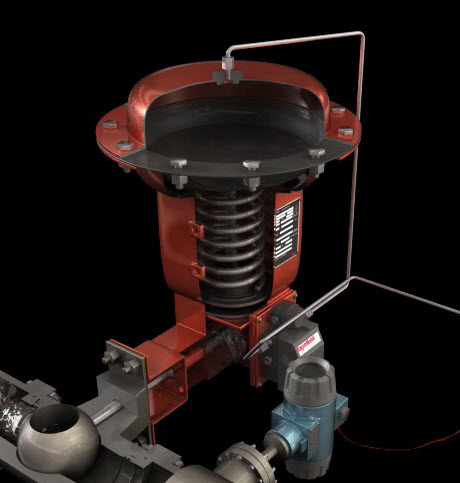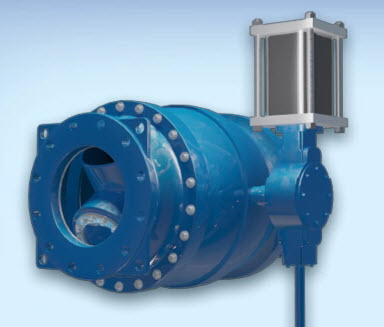A single facility can have hundreds, if not thousands, of valves to control everything from turbine operation to ventilation, to systems that ensure the safety of personnel and equipment. The valves used can range in size from less than an inch to several feet in diameter. While some of these valves are designed to be operated manually, many of them require some form of automatic or remote operation. Operators and technicians must understand the different types of actuators used to operate these valves, and how these actuators work.

Valve actuators are devices used to position valves. They can be used to fully open and shut a valve, or in an application that requires constant and precise control, such as regulating the flow of fuel to a gas turbine, modulate the position of the valve. There are many applications that call for the use of actuators, such as:
- Automating a process
- Positioning valves that require large amounts of torque to operate
- Instantaneous operation of systems used to protect personnel and equipment from dangerous conditions
- Use in controlling areas where manual operation is impractical or impossible
- Continually adjusting systems that must maintain desired parameters
Types
There are three basic types of automatic valve actuators: those that are controlled by pressurized air, by electrical power, or by hydraulic force. Selecting the proper actuator is based on the following considerations:
- The valve application
- The means available to power the actuator
- The speed at which the valve needs to operate
- The amount of force required to operate the valve
- The type of valve to be operated
- The cost versus the benefit for using each type of actuator

Pneumatic
Pneumatic actuators use pressurized air to operate a valve. They do this by applying the force of the air to a piston or a diaphragm attached to the valve stem. Pneumatic actuators are used to provide automatic or semi-automatic valve operation, and are the most popular type in use due to their dependability and simplicity of design.
The advantages of pneumatic actuators include:
- Dependability and simplicity of design
- Fast stroking speeds
- Low fire risk
- Low costs
- Pressurized air can be stored, so the valves can be operated when power is lost
The disadvantages of pneumatic actuators include:
- Poor performance at slow speeds
- Compressibility of air, which can lead to inconsistent speeds of shaft movement
- Impossible to precisely control position, unless fully open or shut
Due to their simple design, high reliability, and low cost, pneumatic diaphragm actuators are used in many industrial applications. For example, pneumatic diaphragm actuators are often used to control cooling water flow in power plants.

Electric
Electric actuators include electric motors and solenoid-actuated valves. Electric motors can be used to open, close, and position a valve manually, automatically, or semi-automatically. The motor operates in both directions and drives the valve stem by means of gear couplings. Solenoid valves use electric power to attract a magnetic slug attached to the valve stem and are used in automatic open-close applications.
The advantages of electric actuators include:
- No source of pressurized air or fluid required
- Useful where low temperatures could cause freezing of condensation in air supply lines
- Capable of producing very large amounts of torque
- Capable of producing consistent and adjustable operating speeds
- Electric cables are easier than piping to route to an actuator
The disadvantages of electric actuators include:
- More expensive and complex than other types of actuators
- Slower comparative operation speeds
- Susceptible to a loss of power
- Potential fire hazard
When a facility is located in a cold enough climate, any moisture trapped in pneumatic control lines can freeze, removing control of that valve. In conditions such as this, many facilities will rely on electric motor actuators for reliability and efficiency during extreme temperatures.

Hydraulic
Hydraulic actuators use a pressurized fluid to control valve movement. The hydraulic fluid used is either water or oil and is fed to either one or both sides of a piston to cause movement. Hydraulic valves provide for automatic and semi-automatic valve operation.
The advantages of hydraulic actuators include:
- More powerful than a pneumatic actuator of the same size
- Precise control of valve position
- Capable of converting a small input pressure into a large output pressure
- Incompressibility of the fluid, which means very little energy is lost during operation
The disadvantages of hydraulic actuators include:
- External hydraulic pump required
- Efficiency can be influenced by changes in temperature
- More expensive and complex than pneumatic actuators
- Can leak, causing a potential fire hazard
Hydraulic actuators are often used to operate the main stop and control valves for high-pressure steam turbine piping. The actuator’s ability to operate the valve against the high-pressure steam, as well as the ability to quickly shut the valve on the loss of control oil, makes hydraulic actuators well suited for this task.

